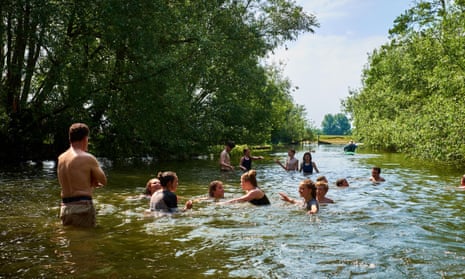A stretch of the Thames is to get bathing status for the first time, in an attempt to ensure the water becomes safe and clean for swimming.
Part of the Wolvercote Mill Stream at Port Meadow, Oxford, an area popular with wild swimmers, will be only the second inland stretch of water to be officially designated as bathing water from next month.
Last year, a stretch of the River Wharfe in Ilkley, Yorkshire became the first river in England to be given bathing status in the hope it would pressure water companies to stop discharging sewage into the picturesque site, where people often swim. The water has not yet been cleaned up and was recently given a poor water quality rating.
Campaigners have been asking for more rivers across England to be given bathing status because it adds requirements to the site that could improve water quality. At these sites, the Environment Agency has to regularly take samples from the water to assess the level of water quality and whether action is needed to cut bacteria levels.
It is hoped that if the areas are branded poor quality, it may pressure water companies to stop discharging raw sewage.
The government is asking local people to nominate areas near them as bathing water sites to ensure areas where people swim, paddleboard and kayak are monitored.
Environment minister Rebecca Pow said: “The residents of Oxford and the Isle of Wight have shown their overwhelming approval for these sites as places to enjoy and connect with nature, so I am pleased to see these locations receiving designated bathing water status. While bathing water quality has improved in recent years and England now has the cleanest bathing waters since records began, we know that water quality at these sites won’t change overnight. It will take time and all those with a role to play must commit to achieve the necessary improvements.
“We are continuing to drive up the quality of lakes, rivers and seas for the public to enjoy through the measures in our Environment Act, and I would encourage more applications for popular bathing areas, both inland and coastal, that may also be suitable for designation.”
Monitoring will begin from 15 May, the beginning of the bathing water season, with results of the water quality tests expected in the autumn. A coastal site at East Cowes Esplanade on the Isle of Wight is also to receive a bathing water designation.
Data released last week showed that water companies discharged raw sewage into English rivers 372,533 times last year, a slight reduction on the previous year. The water companies covering England released untreated sewage for a combined total of more than 2.7m hours, compared with 3.1m hours in 2020.
The government recently revealed its plans to reduce sewage pollution, committing to 70% fewer discharges close to bathing waters by 2035 during the bathing season, with significant reductions expected outside the bathing season as well. However, nature campaigners said the plans fall short and that under them England’s rivers will still be choked by sewage.
